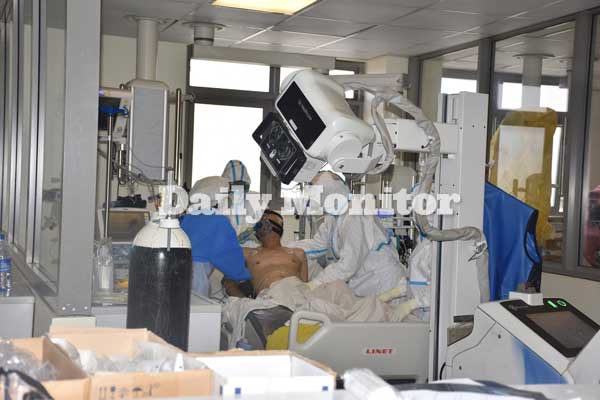Horror of ICU in the eyes of a journalist

Nurses attend to a Covid-19 patient in the Intensive Care Unit at Mulago hospital yesterday. PHOTO | PROMISE TWINAMUKYE
What you need to know:
- We entered a room to change into protective gear. But first, we had to be sanitised before three nurses gave us changing clothes.
- We dropped our clothes for the white extra-large garbs and matching trousers (which fit by tying a knot with the thread) and shirts.
An impromptu trip to take photos in Mulago National Referral Hospital’s Intensive Care Unit (ICU) last week changed my whole view of Covid-19.
At the hospital, eight journalists waited to tour the ICU to help show the public that Covid-19 is real and the current new wave is even more dangerous than the first.
We entered a room to change into protective gear. But first, we had to be sanitised before three nurses gave us changing clothes.
We dropped our clothes for the white extra-large garbs and matching trousers (which fit by tying a knot with the thread) and shirts.
We wore 3M 1860/9132 medical masks topped with a medical cap. We also got 3M medical safety goggles (which were at first comfortable, until I wore them on top of the mask). All this was covered with the disposable Hazmat coverall decorated with a single horizontal and vertical blue line. It had a zipper.
The attire left little room for breathing, hence little chances of inhaling the infected air in the ICU. Our goggles turned cloudy almost instantly.
Boots and gloves on, we left with our clothes in yellow plastic bags to the ICU.
Inside the ICU
A doctor guided us into an elevator that lifted us to the Intensive Care Unit. In our garbs, it felt like a race to the moon.
Shortly, we were in a corridor of white walls with compartments of a top notch facility.
We entered a very white room made of sections separated by glass walls. In the aisle were computers reflecting patients’ lifelines.
About 11 men occupied the beds, five on the left and six on the right. There were two empty beds, which we were told, had been vacated by those who died that morning.
I expected sounds of fear: intense coughing and whooping, but all I heard was the beeping from the machines. The patients were too weak to show physical signs of fighting for their lives. Not even a cry or a whisper.
The patients on my left were seemingly awake, with tubes through which they could get the oxygen. I saw sad faces, which I linked to their fresh memories of seeing fellow patients breathe their last, triggering the fear of them being next.
The patients on my right were worse, especially the white man in the first compartment, whose abdomen moved in and out at a terrible speed as he gasped for breath. His face was covered in masks and tubes. But his fight for life was evident. Like a man drowning in a sea, with a whale in tow.
But like all patients in ICU, no one could tell him “you will make it.” They were alone, except the nurses and doctors who would check on them, occasionally. I had not taken a single picture until a colleague nudged me back into reality.
My legs trembled, but I had to act on duty. Through the fog that had gathered inside my glasses, I tried to focus and take a few usable pictures.
The doctor guide reminded us not to reveal the patients’ faces. It was the wish of those who could say something to him. The others were either subconscious or unconscious. Some seemed to be asleep or in a coma.
As I stared at the thin line between life and death, I could no longer feel the suffocation of the clothes.
“If a pinch of a needle is all it takes to get the immunity against this menacing virus, I must take it,” I told myself, banishing all skepticism I had about the Covid vaccine.
From the ICU we toured two other floors of the High Defensive Units (HDU), with most of the beds having oxygen cylinders. But not as scary as the ICU. Some women could talk, others avoided the camera, and others just sat still.
Here, there are no walls separating patients. A pregnant woman kept adjusting her mask, looking sad—probably worrying for her unborn baby. I felt I had seen enough. After a few interviews, we were ready to leave.
Going out
As we left our cameras behind for fumigation, I was quiet and could hardly smile.
A nurse took us through the careful steps of undressing, to avoid contaminating ourselves.
Undoing the coverall was the hardest since it is presumed it carries the most germs. We threw it in the bin.
Next, we threw the goggles in the disinfectant buckets. We peeled off the boots, easing into other pairs before entering another room, reunited with our clothes. We had a choice of taking a shower in the changing room.
Before leaving this ‘buffer zone’ we had to be sanitized again. The next day I took my first AstraZeneca jab.
ICU capacity
Mulago has an ICU capacity of 27 beds although according to health officials at the facility, these can be scaled up.
Dr Rosemary Byanyima, the deputy executive director of Mulago hospital (pictured above), said before a patient is admitted to the ICU, health workers, especially when there is an upsurge, have to be mobilised to attend to the patient and thus the hospital must be alerted.
Cases: By yesterday, the country had registered a total of 54,669 cases, 388 deaths, 47,760 recoveries and 748,676 vaccinations.



